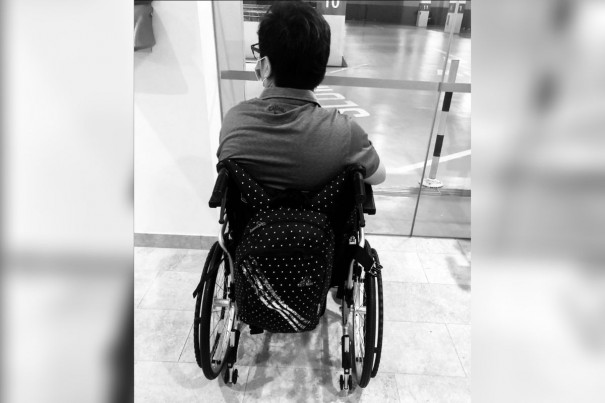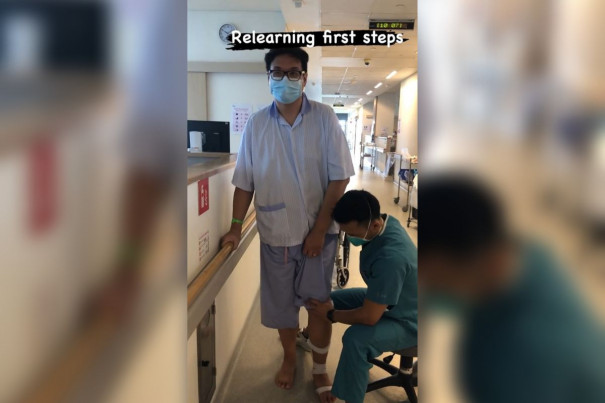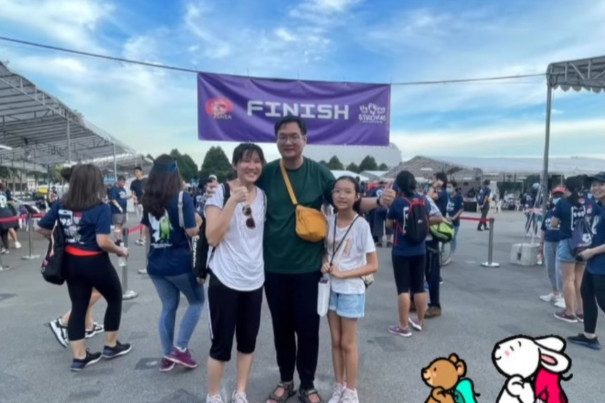Because your stroke medical team WAS A COMPLETE FAILURE AT GETTING YOU 100% RECOVERED; you have to go thru shit like this; grit and determination with nothing to guide you to recovery!
Life after stroke: He records his recovery journey on Instagram to inspire other stroke survivors
Determination, grit and a strong support system help these stroke survivors recover. They share their stories to remind others not to suffer alone or in silence.
|
Audio Version Available
|
One evening in 2021, he was trying to fix a kitchen rack when the simple task suddenly seemed impossibly difficult.
“I was tightening the screws when I felt exhausted, I couldn’t complete the task and had to call my 10-year-old daughter for help,” Kelvin Loon tells The Pride.
The 45-year-old general manager of a business consultancy agency dismissed the incident but when he woke up the next morning, he felt something amiss.
“I was extremely tired and when I tried to walk to my wife to tell her, I almost collapsed on her.”
Kelvin’s wife, June, noticed a tell-tale sign: The left side of his face was drooping.
She rushed him to the A&E. Kelvin was having a stroke.
In 2020, almost 9,000 people suffered a stroke in Singapore. This is an increase from 5,890 in 2010.
A stroke occurs when blood supply to the brain is cut off by a blockage (ischemic) or bleeding (haemorrhagic). When not treated in time, this often results in damage to the brain.
The Singapore National Stroke Association was set up in 1996 to provide a support system for stroke survivors and their caregivers.
Here are three of their stories.
Determination to recover: Kelvin Loon’s story

At the hospital, Kelvin’s symptoms were worsening by the minute.
“I started experiencing aphasia (a condition that leaves the victim unable to speak properly) and the left half of my body was paralysed. I just broke down and cried,” Kelvin recalls.
At that time, he was gripped by fear.
In 2007, his 58-year-old father had a stroke and died after four days in hospital.
Seeing Kelvin undergo the same condition was a scary moment for his family – his mother, wife, and daughter.
“It felt like we were reliving an experience we had with my father,” says Kelvin.
Since it happened during the peak of Covid-19, Kelvin’s family and friends couldn’t visit him in hospital.
It was even lonelier because during his first few days of his five weeks in hospital, he was too disheartened to video call his loved ones.
“I kept thinking to myself, ‘why me?’” says Kelvin.
His doctor had told him that he had a 30 per cent chance of experiencing another stroke, and that sentence kept haunting him, filling him with dread.
But he came to a turning point.
“I decided to reframe my thoughts to be more positive,” he says. “I decided to focus on the things I could do to ensure that I fall in the 70 per cent category of not getting a stroke.”

Apart from reframing his situation, Kelvin also refocused his efforts – to learn a new skill!
“This may sound crazy but while I was hospitalised, I picked up trading and even managed to make some money when I was bedridden,” Kelvin says with a laugh.
Kelvin was discharged after five weeks in hospital. Since the stroke affected the right side of his brain, the left side of his body was weak, leaving him in a wheelchair.
He went through an intensive recovery schedule, attending rehabilitation sessions five days a week.
Even on his days off rehab, he pushed himself to learn basic actions again, like how to step over a step or walking further without resting.
A month after leaving hospital, he stopped using the wheelchair and used a quad stick to move around instead.
So, what kept him going?
Kelvin says that his motto is “the choices you make are important”. He knew that he wanted to regain his health so he made the choices that can best help him in his recuperation journey.
With support from his wife and his mother, Kelvin returned to work seven months after his stroke.

During his road to recovery, Kelvin decided to document his story on Instagram. He wanted to have a visual record of his progress to motivate him to persevere.
However, that wasn’t all he wanted to do.
“I also wanted to encourage others who are recovering from a stroke, to continue exercising,” says Kelvin.
No comments:
Post a Comment